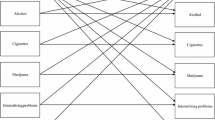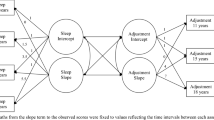Abstract
Sleep problems are associated with problematic adjustment in toddlers, but less is known regarding the direction of association between specific sleep problems and adjustment. To address this gap, we used data from the National Institute of Child Health and Human Development Study of Early Child Care and Youth Development (N = 1001) to examine reciprocal associations between sleep problems and behavior problems from 24- to 36-months. Results from cross-lagged path models suggested specificity of associations between type of sleep problem and behavior problem. Specifically, there were reciprocal associations between trouble getting to sleep and internalizing problems, and unidirectional links between externalizing problems and bedtime resistance from 24- to 36-months. Internalizing and externalizing problems at 24 months, however, predicted increases in bedtime resistance from 24- to 36-months for boys, but not girls. Findings highlight specific relations between sleep problems and internalizing and externalizing problems during toddlerhood, and the importance of examining sex differences.




Similar content being viewed by others
References
Gregory AM, Sadeh A (2016) Annual research review: Sleep problems in childhood psychiatric disorders—a review of the latest science. J Child Psychol Psychiatry 57(3):296–317
Quach J, Hiscock H, Canterford L, Wake M (2009) Outcomes of child sleep problems over the school-transition period: Australian population longitudinal study. Pediatrics 123(5):1287–1292
Troxel WM, Trentacosta CJ, Forbes EE, Campbell SB (2013) Negative emotionality moderates associations among attachment, toddler sleep, and later behavior problems. J Fam Psychol 27(1):127–136
Sivertsen B, Harvey AG, Reichborn-Kjennerud T, Torgersen L, Ystrom E, Hysing M. (2015). Later emotional and behavioral problems associated with sleep problems in toddlers: a longitudinal study. JAMA Pediatr 169(6):575–82
El-Sheikh M, Buckhalt JA (2015) Moving sleep and child development research forward: priorities and recommendations from the SRCD-sponsored forum on sleep and child development. Monogr Soc Res Child Dev 80:15–32
Anders TF, Dahl RE (2007) Classifying sleep disorders in infants and toddlers. In: Narrow WN, First MB, Sirovatka P, Regier DA (eds) Age and gender considerations in psychiatric diagnosis: a research agenda for DSM-V. American Psychiatric Association, Arlington
Hewitt K, Powell I, Tait V (1989) The behaviour of 9-month and 2-year olds as assessed by health visitors and parents. Health Visit 62(2):52–5
Johnson CM (1991) Infant and toddler sleep: a telephone survey of parents in one community. J Dev Behav Pediatr 12(2):108–114
Byars KC, Yolton K, Rausch J, Lanphear B, Beebe DW (2012) Prevalence, patterns, and persistence of sleep problems in the first 3 years of life. Pediatrics 129(2):e276–e284
Betramini AU, Hertzig ME (1983) Sleep and bedtime behavior in preschool-aged children. Pediatrics 71(2):153–158
Crowell J, Keener M, Ginsburg N, Anders T (1987) Sleep habits in toddlers 18- to 36-months-old. J Am Acad Child Adolesc Psychiatry 26(4):510–515
Blader JC, Koplewicz HS, Abikoff H, Foley C (1997) Sleep problems of elementary school children. A community survey. Arch Pediatr Adolesc Med 151(5):473–480
Dahl RE (1996) The regulation of sleep and arousal: development and psychopathology. Dev Psychopathol 8:3–27
Kopp CB (1989) Regulation of distress and negative emotions: a developmental view. Dev Psychol 25(3):343–354
Sadeh A, Anders TF (1993) Sleep disorders. In: Zeanah CH (ed) Handbook of infant mental health. Guilford, New York, pp 305–316
Miller AL, Seifer R, Crossin R, Lebourgeois MK (2015) Toddler’s self-regulation strategies in a challenge context are nap-dependent. J Sleep Res 24:279–287
Northerner LM, Trentacosta CJ, McLear CM (2016) Negative affectivity moderates associations between cumulative risk and at-risk toddlers’ behavior problems. J Child Fam Stud 25:691–699
Putnam SP, Stifter CA (2005) Behavioral approach-inhibition in toddlers: prediction from infancy, positive and negative affective components, and relations with behavior problems. Child Dev 76(1):212–226
Calkins SD, Dedmon SE (2000) Physiological and behavioral regulation in 2-year-old children with aggressive/destructive behavior problems. J Abnorm Child Psychol 28(2):103–118
Cortese S, Faraone SV, Konofal E, Lecendreux M (2009) Sleep in children with attention-deficit/hyperactivity disorder: meta-analysis of subjective and objective studies. J Am Acad Child Adolesc Psychiatry 48(9):894–908
Hansen BH, Shirbekk B, Oerbeck B, Richter J, Kristensen H (2011) Comparison of sleep problems in children with anxiety and attention deficit/hyperactivity disorders. Eur Child Adolesc Psychiatry 20(6):321–330
Carvalho Bos S, Gomes A, Clemente V, Marques M, Pereira AT, Maia B, Soares MJ, Cabral AS, Macedo A, Gozal D, Azevedo MH (2009) Sleep and behavioral/emotional problems in children: a population-based study. Sleep Med 10(1):66–74
Molfese VJ, Rudasill KM, Prokasky A, Champagne C, Holmes M, Molfese DL, Bates JE (2015) Relations between toddler sleep characteristics, sleep problems, and temperament. Dev Neuropsychol 40(3):138–154
Wilson KE, Lumeng JC, Kaciroti N, Yu-Pu Chen S, LeBourgeois MK, Chervin RD, Miller AL (2015). Sleep hygiene practices and bedtime resistance in low-income preschoolers: does temperament matter? Behav Sleep Med: 1–12
Goodnight JA, Bates JE, Staples AD, Pettit GS, Dodge KA (2009) Temperamental resistance to control increases the association between sleep problems and externalizing behavior development. J Fam Psychol 21(1):39–48
Shanahan L, Copeland WE, Angold A et al (2014) Sleep problems predict and are predicted by generalized anxiety/depression and oppositional defiant disorder. J Am Acad Child Adolesc Psychiatry 53(5):550–558
Kelly RJ, El-Sheikh M (2014) Reciprocal relations between children’s sleep and their adjustment over time. Dev Psychol 50(4):1137–1147
Gregory AM, O’Conner TG (2002) Sleep problems in childhood: a longitudinal study of developmental change and associations with behavioral problems. J Am Acad Child Adolesc Psychiatry 41(8):964–971
Jansen P, Saridjan N, Hofman A et al (2011) Does disturbed sleeping precede symptoms of anxiety or depression in toddlers? The generation R study. Psychosom Med (Baltimore) 73(3):242–249
Belanger ME, Bernier A, Simard V, Desrosiers K, Carrier J (2015) Sleeping towards behavioral regulation: relations between sleep and externalizing symptoms in toddlers and preschoolers. J Clin Child Adolesc Psychol 25:1–8
Maccoby EE, Jacklin CN (1974) The psychology of sex differences. Stanford University Press, Stanford
Kochanska G, Coy KC, Murray KT (2001) The development of self-regulation in the first 4 years of life. Child Dev 72(4):1091–1111
Kochanska G, Murray KT, Harlan ET (2000) Effortful control in early childhood: continuity and change, antecedents, and implications for social development. Dev Psychol 36(2):220–232
NICHD Early Child Care Research Network (2002) Early child care and children’s development prior to school entry: results from the NICHD study of early child care. Am Educ Res J 39:133–164
Achenbach TM (1992) Manual for the child behavior checklist/2–3 and 1992 profile, 1st ed. University of Vermont, Department of Psychiatry, Burlington
Gregory AM, Cousins JC, Forbes EE, Trubnick L, Ryan ND, Axelson DA et al (2011) Sleep items in the Child Behavior Checklist: a comparison with sleep diaries, actigraphy, and polysomnography. J Am Acad Child Adolesc Psychiatry 50:499–507
NICHD Early Child Care Research Network (1998) Early child care and self-control, compliance, and problem behavior at twenty-four and thirty-six months. Child Dev 69(4):1145–1170
Carey WB, McDevitt SC (1978) Revision of the Infant Temperament Questionnaire. Pediatrics 61:735–739
Pluess M, Belsky J (2009) Differential susceptibility to rearing experience: the case of childcare. J Child Psychol Psychiatry 50(4):396–404
Radloff LS (1977) The CES-D Scale: A self-report depression scale for research in the general population. Appl Psychol Meas 1(3):385–401
NICHD Early Child Care Research Network (1999) Child care and mother–child interaction in the first 3 years of life. Dev Psychol 35:1399–1413
StataCorp (2013) Stata statistical software: release 13. StataCorp LP, College Station
Sadeh A (1996) Evaluating night waking in sleep-disturbed infants: a methodological study of parental reports and actigraphy. Sleep 19(10):757–762
Berger RH, Miller AL, Seifer R, Cares SR, Lebourgeois MK et al (2012) Acute sleep restriction effects on emotion responses in 30- to 36-month-old children. J Sleep Res 21:235–246
LeBourgeois MK, Harsh JR (2016) Development and psychometric evaluation of the Children’s Sleep-Wake Scale. Sleep Health. doi:10.10106/j.sleh2016.04.001
Author information
Authors and Affiliations
Corresponding author
Rights and permissions
About this article
Cite this article
Conway, A., Miller, A.L. & Modrek, A. Testing Reciprocal Links Between Trouble Getting to Sleep and Internalizing Behavior Problems, and Bedtime Resistance and Externalizing Behavior Problems in Toddlers. Child Psychiatry Hum Dev 48, 678–689 (2017). https://doi.org/10.1007/s10578-016-0692-x
Published:
Issue Date:
DOI: https://doi.org/10.1007/s10578-016-0692-x




